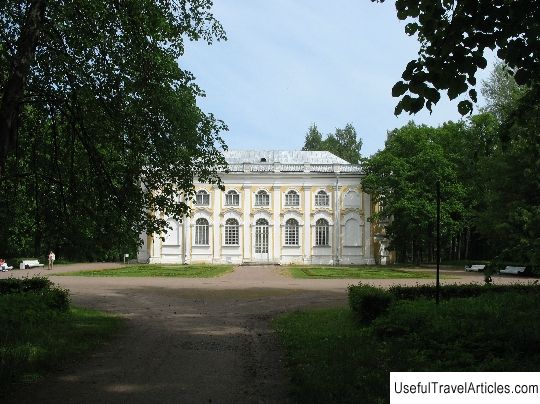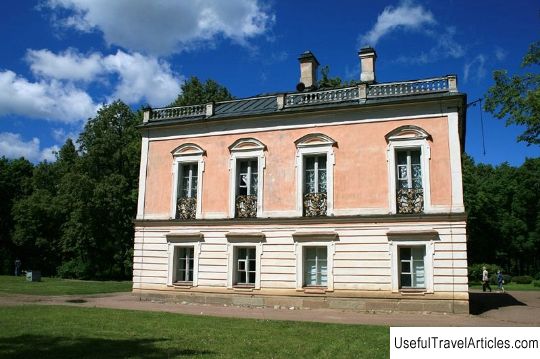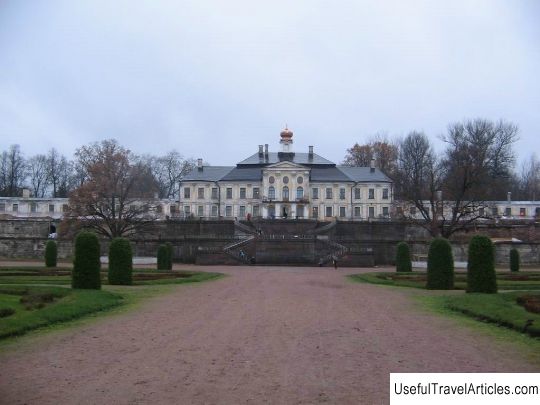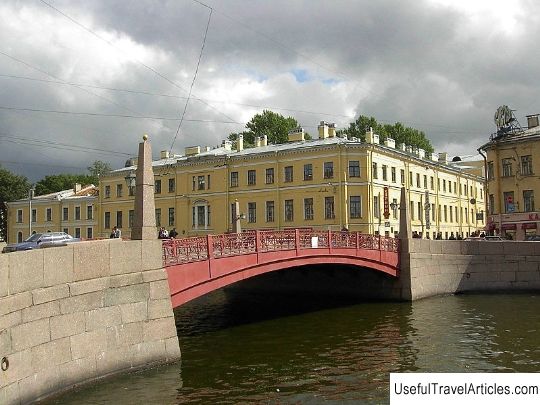Pavilion ”Stone Hall” description and photos - Russia - St. Petersburg: Lomonosov (Oranienbaum)
Rating: 8,6/10 (1797 votes) 
Pavilion "Stone Hall" description and photos - Russia - St. Petersburg: Lomonosov (Oranienbaum). Detailed information about the attraction. Description, photos and a map showing the nearest significant objects. Photo and descriptionThe "Stone Hall" pavilion is located on the axis of the Triple Linden Alley, on the edge of a natural coastal ridge. A U-shaped pond stretches in front of the southern facade. Two stone bridges with granite curbstones and iron railings were erected across the pond. This entire ensemble already existed in the middle of the 18th century. "One-storey with a mezzanine", as they said then, in the 18th century, from the western and eastern sides, adjoined wooden wings with an L-shaped plan. A small palace, known in documents as the "Stone Hall" , was built in Oranienbaum in 1750-1752. The author of The Stone Hall is B.F. Rastrelli, builder - M.L. Hoffman. In the materials of the 1750s, the building is called either the New Palace, then the Masquerade Hall and, finally, the Concert Hall. Following from the name, it was intended for performances, concerts and masquerades. Therefore, a large hall and stage were formed here. It is a well-known fact that in July 1757, Grand Duchess Ekaterina Alekseevna wished, on the occasion of her husband's birthday, Emperor Peter Fedorovich, to arrange a magnificent celebration, at which a dramatic cantata with words A. Denuy (poet from Italy) "Prophesying Urania". The work was translated by M.V. Lomonosov. For this performance, Lomonosov designed a "machine" consisting of many globes and spheres on which Urania, the muse of astronomy, sat. By 1784, the "Stone Hall" was most likely no longer used. Archive documents indicate that it lacks interior decor and appliances. In 1808, the pavilion was transferred to the military land hospital. During the 19th-20th centuries, it was repeatedly rebuilt. In 1824 the architect V.P. Stasov remade it. In 1843, a major reconstruction of the building was carried out. It was adapted as a church - the family temple of Mecklenburg-Strelitzky, which was consecrated in January 1847. In 1902-1904 the architect O.A. Paulsen erects a stone bell tower over the western part. In this form, the "Stone Hall" was preserved until 1967, when the architect M.M. Plotnikov, it was recreated in its original form. From Paulsen's alteration, the apse has been preserved in the eastern part of the building, and the portal risalit in the western part. "Stone Hall" is a majestic two-story building, ending with a balustrade with a high roof, built in the Baroque style. Its facade is plastically enlivened by pilasters, uniting both floors. This gives the structure's elongated rectangular outline a certain slenderness. In addition, the composition of the extreme walls contributes to this. Unlike the other five, they have no windows. They are replaced by flat niches. Their framing is similar to window frames. The character of the drawing is baroque. On the first floor, the windows are semicircular, on the second - curly. They are enclosed in lush relief platbands and highlighted with curved sandrids. The interior makes a spectacular impression - the rectangular hall is divided into 3 parts by six four-sided Corinthian columns. They support the choir, which is surrounded by a balustrade. The pilasters of the same order echo the columns. Today the Stone Hall pavilion functions as a concert and exhibition hall. Since 2003, a sculpture has been exhibited here, including exhibited in the Hall of the Muses of the Chinese Palace, marble busts of Lucretia and Cleopatra. Lucretia was dishonored by the king's son. After that, unable to survive the shame, she committed suicide. The moment of suicide was captured by an 18th century Italian sculptor. In addition, the bust of Cleopatra, the Egyptian queen of the 1st century BC, who became famous for her extraordinary beauty, quirks and love adventures, belongs to the same period of time.        Topic: Pavilion ”Stone Hall” description and photos - Russia - St. Petersburg: Lomonosov (Oranienbaum). |




